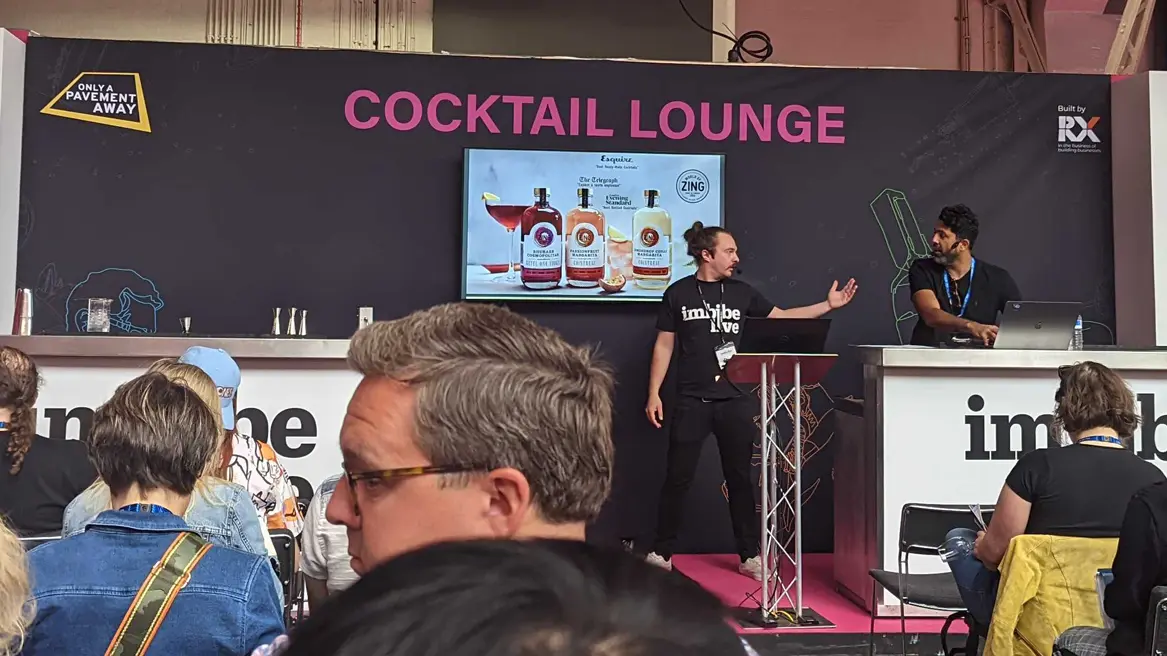The UK’s largest drinks industry exhibition – Imbibe Live – returned in London and, although smaller than we remembered from pre-pandemic times, was packed full of startups and established brands keen to showcase their latest innovations direct to the nation’s bartenders.
If you didn’t make it down, here’s the Democracy edit on the trends to watch out for in late 2022 and beyond.
1) Low and no to take on the on-trade
Think bar goers are only interested in booze? Think again.
We spotted a plethora of startups like Mavrik non-alcoholic cocktails pitching 0% cocktails to the on-trade. We also had a chance to catch up with some of the more established players in the field like Eisberg – the UK’s number one alcohol-free wine (and our lovely client).
In a talk on upcoming trends, bartenders were keen to explain that it’s not all about the ABV any more, it’s about flavour and fun – and guests are demanding lots of it.
The good old shandy is having a revival as well – as professionals are experimenting with combinations like Asahi and Cawstones ginger, or Camden Hells and Rhubarb soda. Refreshment and depth – without being super sweet.
2) Cold served herbal tea
Drinks innovator and one of the UK’s leading drinks experts, Pritesh Mody, told us about how he uses cold served teas to create flavour complex cocktails. A simple serve made of a herbal tea steeped in hot water and allowed to cool, a splash of syrup, topped up with soda water or tonic and served in a highball glass with ice and garnish.
Pritesh, a regular presenter on Channel 4’s Sunday Brunch, encouraged bar professionals to experiment with tea of all varieties and flavours to create sophisticated cocktails and mocktails. He suggested an Earl Grey Collins, but the possibilities here are endless.
3) Batch Made Cocktails
At a time when consumers’ demand for cocktails is at a record high, the industry is struggling to recruit and train bar staff. Step forward the plethora of premixed cocktail brands that were showcasing their products promising to deliver consistent serves in a fraction of the time.
In a talk on upcoming trends, much was made of how experienced bartenders could start making batch cocktails with added preservatives and stabilisers that could infuse over a longer period and be sold to regular customers as an added value e.g. chose a seven day or a 21 day infused margarita.
Alternatively, there were plenty of plug and play options offering a variety of quality liquids that would meet the pocket of any pub keen to meet the growing demand for cocktails without investing in the training.
For us, the danger here lies in consumer perceptions around value. Cocktails command a premium price tag and bring a healthy margin. By de-skilling the serve, margins will be put under pressure too and the on-trade will have to do more to enhance the experience, or face a reduction in margin.
4) CBD
Said to outsell vitamins C and D combined, everyone is taking a fresh look at CBD products and culture. We heard from the founder of INTUNE, Hannah Glasson, who has created a deliciously vibrant grown-up CBD brand, seen in bars, festival fields and foodie spots in the past 12 months.
Like many champions of CBD, Hannah discovered the benefits personally following breast cancer treatment. During this time, she shared, CBD helped her feel more present, focused and productive – so she thought, why not share that with other people who need it?
Like caffeine, finding the right level of CBD for the individual requires interpretation. But the potential for an alternative to alcohol to help the nation relax is really interesting.
CBD products are going through a legislative process at the moment, and no new products are allowed to be launched until this process has reached its conclusion. When this reaches its conclusion, we anticipate rapid growth in the sector.
5) Seasonal angle
As avid readers of foodie media, what’s in season is always a hot topic of conversation with journos. But now the drinks industry is turning its eyes towards seasonal produce too.
Strongly linked to sustainability, the practice of using local and seasonal produce doesn’t mean only serving strawberry cocktails in berry season – linking back to preparation and batching, it can also mean conserving ingredients to offer consumers a wider selection at any time.
Sustainability and innovation are two of the big drives when it comes to consumer demands – and using local and seasonal produce feeds into both. Like swapping the mint in a mojito for basil – don’t deny it until you try it!

